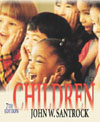John W. Santrock,
University of Texas, Dallas
| altruism | unselfish interest in helping another person.
(See 438)
|
 |
 |
 |
| androgyny | the presence of desirable masculine and feminine characteristics in the same individual.
(See 442)
|
 |
 |
 |
| boundary ambiguity | the uncertainty in stepfamilies about who is in or out of the family and who is performing or responsible for certain tasks in the family system.
(See 448)
|
 |
 |
 |
| care perspective | the moral perspective of Carol Gilligan, that views people in terms of their connectedness with others and emphasizes interpersonal communication, relationships with others, and concern for others.
(See 437)
|
 |
 |
 |
| cognitive constructivist approaches | approaches that emphasize the child's active, cognitive construction of knowledge and understanding. Piaget's theory is an example of this approach.
(See 455)
|
 |
 |
 |
| controversial children | children who are frequently nominated both as someone's best friend and as being disliked.
(See 450)
|
 |
 |
 |
| conventional reasoning | the second, or intermediate, level in Kohlberg's theory of moral development. Internalization is intermediate. Individuals abide by certain standards (internal), but they are the standards of others (external), such as parents or the laws of society.
(See 434)
|
 |
 |
 |
| direct instruction approach | a structured, teacher-centered approach to teaching that is characterized by teacher direction and control, high teacher expectations for students' progress, maximizing the time students spend on academic tasks, and keeping negative affect to a minimum.
(See 455)
|
 |
 |
 |
| emotional intelligence | a form of social intelligence that involves the ability to monitor one's own and others' feelings and emotions, to discriminate among them, and to use this information to guide one's thinking and action.
(See 430)
|
 |
 |
 |
| gender-role transcendence | the belief that, when an individual's competence is at issue, it should not be conceptualized on the basis of masculinity, femininity, or androgyny but, rather, on a personal basis.
(See 444)
|
 |
 |
 |
| gender stereotypes | broad categories that reflect our impressions and beliefs about females and males.
(See 440)
|
 |
 |
 |
| internalization | the developmental change from behavior that is externally controlled to behavior that is controlled by internal standards and principles.
(See 434)
|
 |
 |
 |
| intimacy in friendships | self-disclosure and the sharing of private thoughts.
(See 454)
|
 |
 |
 |
| justice perspective | a moral perspective that focuses on the rights of the individual; individuals independently make moral decisions.
(See 437)
|
 |
 |
 |
| neglected children | children who are infrequently nominated as a best friend but are not disliked by their peers.
(See 450)
|
 |
 |
 |
| perspective taking | the ability to assume another person's perspective and understand his or her thoughts and feelings.
(See 427)
|
 |
 |
 |
| popular children | children who are frequently nominated as a best friend and are rarely disliked by their peers.
(See 450)
|
 |
 |
 |
| postconventional reasoning | the highest level in Kohlberg's theory of moral development. Morality is completely internalized.
(See 435)
|
 |
 |
 |
| preconventional reasoning | the lowest level in Kohlberg's theory of moral development. The individual shows no internalization of moral values-moral reasoning is controlled by external rewards and punishments.
(See 434)
|
 |
 |
 |
| rapport talk | the language of conversation and a way of establishing connections and negotiating relationships.
(See 441)
|
 |
 |
 |
| rejected children | children who are infrequently nominated as a best friend and are actively disliked by their peers.
(See 450)
|
 |
 |
 |
| report talk | talk that gives information, such as public speaking.
(See 441)
|
 |
 |
 |
| self-concept | domain-specific evaluations of the self.
(See 428)
|
 |
 |
 |
| self-esteem | the global evaluative dimension of the self. Self-esteem is also referred to as self-worth or self-image.
(See 428)
|
 |
 |
 |
| social constructivist | approaches to teaching that emphasize the social contexts of learning and knowledge as mutually built and constructed.
(See 460)
|



 2003 McGraw-Hill Higher Education
2003 McGraw-Hill Higher Education